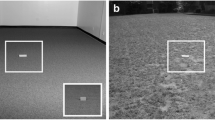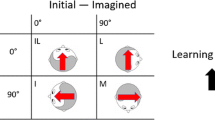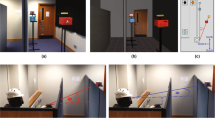Abstract
Two experiments were carried out: the control experiment and the doubling-distance experiment. In the control experiment subjects were presented with two visual stimuli whose distance was randomly varied. Subjects were required to reproduce the interstimulus remembered distance in two conditions. In one condition (reproduction by pointing) they pointed to a virtual position in space. In the other condition (visual reproduction) they matched the distance by using two other visual stimuli. In the doubling-distance experiment, distances between the two randomly presented stimuli were half of the distances used in the control experiment. Subjects were required to reproduce the double of the presented distance. As in the control experiment, reproduction was executed in two conditions: reproduction by pointing and visual reproduction. In both experiments variable and constant errors were measured. Pointing kinematics were also analysed. The results of the control experiment showed that subjects underestimated distance in reproduction by pointing, whereas they overestimated distance in visual reproduction. Variable errors increased with increasing distance, whereas they were not influenced by the type of reproduction. In the doubling-distance experiment, subjects generally overestimated distance by the same amount in both conditions. However, overestimation decreased with distance during reproduction by pointing. Pointing kinematics varied between the two experiments. The results of the control experiment confirm the hypothesis that perceptual judgement and visuo-motor transformation are two separate processes during which the same object attributes are independently analysed. However, the results of the doubling-distance experiment suggest that perceptual judgement and visuo-motor transformation use the same mechanisms when object attributes are deduced by mental elaboration.
Similar content being viewed by others
References
Bridgeman B (1991) Complementary cognitive and motor image processing. In: Olbrecht G, Stark LW (eds) Presbyopia research: from molecular biology to visual adaptation. Plenun, New York, pp 189–198
Bridgeman B, Kirch M, Sperling A (1981) Segregation of cognitive and motor aspects of visual function using induced motion. Percept Psychophys 29: 336–342
Brown JC, Knauft EB, Rosenbaum G (1948) The accuracy of positioning reactions as a function of their direction and extent. Am J Psychol 61: 167–182
Darling WG, Miller GF (1993) Transformation between visual and kinaesthetic coordinate systems in reaches to remembered object locations and orientations. Exp Brain Res 93: 534–547
Elliot D, Madalena J (1987) The influence of premovement visual information on manual aiming. Q J Exp Psychol 39A: 541–559
Fisk JD, Goodale MA (1985) The organization of eye and limb movements during unrestricted reaching to targets in contralateral and ipsilateral visual space. Exp Brain Res 60: 159–178
Gentilucci M, Negrotti A (1994) Dissociation between perception and visuomotor transformation during reproduction of remembered distances. J Neurophysiol 72: 2026–2030
Gentilucci M, Toni I, Chieffi S, Pavesi G (1994) The role of proprioception in the control of prehension movements: a kinematic study in a peripherally deafferented patient and in normal subjects. Exp Brain Res 99: 483–500
Gentilucci M, Chieffi S, Daprati E, Toni I, Saetti MC (in press) Visual illusion and action. Neuropsychologia
Gnadt JW, Bracewell RM, Andersen RA (1991) Sensorimotor transformation during eye movements to remembered visual target. Vision Res 4: 693–715
Goodale MA, Milner AD, Jakobson LS, Carey DP (1991) A neurological dissociation between perceiving objects and grasping them. Nature 349: 154–156
Goodale MA, Jakobson LS, Keillor JM (1994) Differences in the visual control of pantomimed and natural grasping movements. Neuropsychologia 10: 1159–1178
Jeannerod M (1984) The timing of natural prehension movements. J Mot Behav 16: 235–154
Meyer DE, Smith KJE, Kornblum S, Abrams RA, Wright CE (1990) Speed-accuracy in aimed movements: towards a theory of rapid voluntary action. In: Jeannerod M (ed) Motor representation and control. (Attention and performance XIII) Erlbaum, Hillsdale, NJ, pp 171–227
Milner AD, Goodale MA (1993) Visual pathways to perception and action. Prog Brain Res 95: 317–337
Milner AD, Perret DI, Johnston RS, Benson PJ, Jordan TR, Heeley DW, Bettucci D, Mortara F, Mutani R, Terrazzi E, Davidson DLW (1991) Perception and action in visual form agnosia. Brain 114: 405–428
Pelisson D, Prablanc C, Goodale MA, Jeannerod M (1986) Visual control of reaching movements without vision of the limb. II. Evidence of fast unconscious processes correcting the trajectory of the hand in the final position of a double-step stimulus. Exp Brain Res 62: 303–311
Poulton EC (1980) Range effects and asymmetric transfer in studies of motor skills. In: Nadeau CM (eds) Psychology of motor behavior and sport. Human Kinetics Champaign. Il, pp 339–359
Slack CW (1953) Some characteristics of the “range effect”. J Exp Psychol 46: 76–80
Schmidt RA (1988) Motor learning and control: a behavioral emphasis (2nd edn). Human Kinetics, Champaign, Il
Soechting JF, Flanders M (1989a) Sensorimotor representation for pointing to targets in three-dimensional space. J Neurophysiol 62: 582–594
Soechting JF, Flanders M (1989b) Errors in pointing are due to approximations in sensorimotor transformation. J Neurophysiol 62: 595–608
Ungerleiger LG, Mishkin M (1982) Two cortical visual systems. In: Ingle DJ, Goodale MA, Mansfield RJW (eds) Analysis of visual behavior. MIT Press, Cambridge, Mass, pp 549–586
Wong E, Mack A (1981) Saccadic programming and perceived location. Acta Psychol 48: 123–131
Woodworth RS (1899) The accuracy of voluntary movement. Psychol Rev Suppl 3, No 3
Author information
Authors and Affiliations
Rights and permissions
About this article
Cite this article
Gentilucci, M., Negrotti, A. Mechanisms for distance reproduction in perceptual and motor tasks. Exp Brain Res 108, 140–146 (1996). https://doi.org/10.1007/BF00242911
Received:
Accepted:
Issue Date:
DOI: https://doi.org/10.1007/BF00242911




